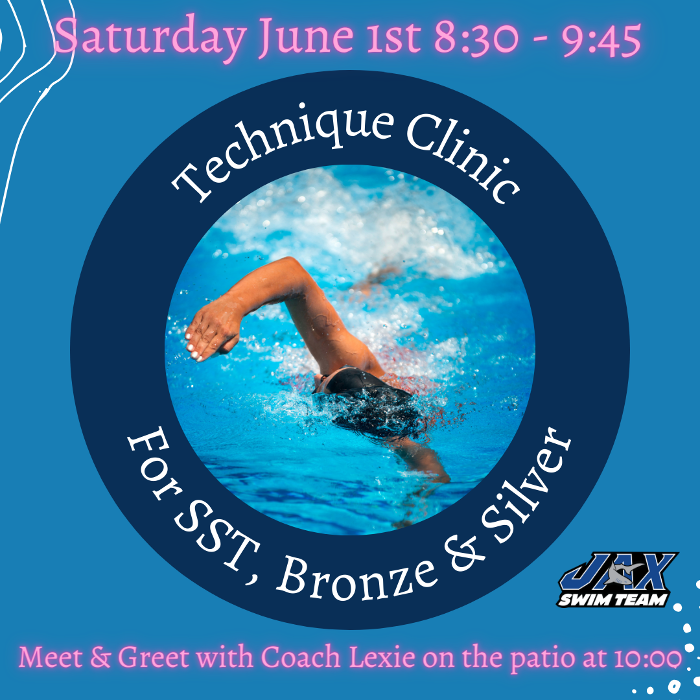Team Clinic Day

Thank you to everyone who came and participated in the Team Clinic on Saturday! It was so fun to get together and learn all about swim meets! Our coaches were in the water assisting the swimmers learning about their starts, flip turns & how to finish a race! I feel very excited to see how this first MSS meet will go :)
Swim meets can be overwhelming and daunting to those who have never experienced one before. Here I will provide you with some things that will help ease any anxiety! Once you get through your first meet, everything will make so much more sense! No two swim meets ever run exactly the same. The most important thing to remember is to be flexible. It’s ok to be a little confused at first. Don’t be afraid to approach someone from our team to ask a question.
The Swim Bag
In addition to the routine stuff to bring to practice (swimsuit, towel, goggles and cap), you will want/need a few more things for a swim meet. Here’s a basic checklist:
- Extra-large towel or blanket for your swimmer to keep warm between races or sit on if necessary
- Towels…two are better than one
- Loose fitting, comfortable clothing to wear in between races
The “Other” Bag
Do NOT underestimate the importance of “The Other Bag”. This is the activity bag to keep your swimmers happy and busy while they wait for their events to be called. Rest is important, particularly at the long invitational meets; here are some suggestions for quiet, yet fun activities:
- Electronic games
- Cards, Travel Games
- Books
- iPad
Remember to label all your items and keep an eye on your things! You are out in public and at a large event where many people are not always paying close attention. Theft can happen anywhere.
What Parents Need
While some people enjoy watching the competitors and spend nearly all of their time in the pool area, other people prefer to relax with their children in between events. You may want to consider bringing some of the following:
- A comfortable folding chair (rock-hard gymnasium floors and unforgiving bleacher seats will get uncomfortable as the day progresses)
- Pen, magic marker, highlighter
- Book, paper, magazine
- Be sure to dress in layers or bring some lightweight clothing to change into.
The Cooler
If you opt to pack food/drinks, here are some good and bad swim meet food choices:
Good:
- Water, juice, sports drink (fluids are VERY important) NO SODA
- Bagels (hold the cream cheese)
- Carrot and celery stick
- Fruit – grapes, bananas & apples (oranges can be messy)
- Granola bars, oatmeal
- Plain or artificially sweetened yogurt
Think natural energy. Easily digestible, portable foods are your best choice.
Bad:
- Candy & sweets (anything with heavy sugar content)
- Fatty foods (takes too long to digest)
- Greasy, heavy foods (no nutritional value)
FLUIDS ARE VERY IMPORTANT! Even slight dehydration can cause cramping and fatigue and a bad swim meet experience. Encourage your swimmer to hydrate all day long. Moderate your child’s food intake and remember less is better. Some kids think they’re hungry when really they’re bored and looking for something to do. Now that you’re all packed…tuck the kids in bed. Swimmers need a good night’s sleep. Most meets start early! Make sure you know the warm-up times and have planned to arrive at least 15 minutes prior.
The Arrival
What do I do FIRST? When you first arrive, have your swimmer go to the designated locker area and change into their swimsuit. They should take their cap, goggles, and towel and immediately report to their coach in the pool area. Pick out your “camping” spot. If outdoors, set up your tent and chairs. If in a gym, set up your chairs and put out your blanket so your swimmer has a place to hang out while waiting for their next race. Heat Sheet Next, go and purchase your heat sheet/ or find it online. While your swimmer is warming up, this is the time to get out your highlighter and mark your swimmer’s events. Once your swimmer returns, make sure they drink something and wrap up in either a blanket or towel if it is cold. They should just hang out and rest for their first race! It is also a good time to make sure they know their events. A very convenient place to write them down is on the back of your child’s hand or arm. Remember to use a waterproof marker or pen. Sharpies are perfect! You will see most of the 10 and under kids with this.
Here is an example: The first number represents the event number, the second the heat number and the third the lane number and finally the distance and stroke abbreviation. 10/3/5 – 25 fr = Event 10, Heat 3, Lane 5 in the 25 free event 16/2/4 – 50 bk = Event 16, Heat 2, Lane 4 in the 50 back Don’t worry too much; your child will get a helpful reminder at Clerk of Course and also on deck before they jump in the water. The important thing is that your child remains either on the pool deck or in the gym where they can hear the clerk of course workers call the event numbers. They will not wait on a swimmer who is not on the block when it is their time.
The Meet
If we’re at another team’s hosted meet, this is a great time to scope out their facility a bit. Make sure you know where the clerk of course is, the restrooms and of course the pool area, and finally how to get back to your camp. Make sure that your swimmer stays warm and hydrated. The body uses energy to warm itself and energy is something to conserve before events. Make sure that they keep up with their cap and goggles – there’s nothing more nerve-wracking than searching for caps and goggles seconds before it's time to report. If they keep their caps on and goggles pulled down like a necklace, they’re less likely to lose them. Your main job at this point is to make sure your child stays nearby between events as opposed to wandering the facility.
There will be several whistles sounded at a swim meet and they all mean different things. Here's a quick overview: Short whistles get ready to swim. You should be behind your block ready to swim your race when you hear this. Long Whistle = get on your block or get in the water for backstroke starts. Next, Take Your Mark . . . Beep! By now, most people should be quieter. The whistles have let them know what’s going on too. If not, the starter might ask them to quiet down. The next thing you’ll hear is the starter say, “Take Your Mark.” Then, when everyone is ready, you’ll hear the starter device “Beep.”
People are constantly moving in and out of the pool area and you will notice there is a lot of activity going on. Resist the temptation to go see your child. After the race, your swimmer will head back to your spot where you can meet them and give them their much-deserved kudos! Remember that as a parent you are not allowed behind the blocks, to discuss time with the timers, or approach the stroke and turn judges. If there is a question or problem, you should ask your coach who will then handle it for you. Note: Your child must speak to their coach both before and after their race. This is VERY IMPORTANT! This is a great way to get immediate feedback during a race setting.
After your swimmer races and speaks to the coach, they should head to the cool-down pool and swim at least a 100 (4 laps) to loosen up.
Once your swimmer has completed their races, have them check in with the coach before leaving the meet. Depending on the meet, the coach may want swimmers to stay and cheer on the rest of their teammates. NEVER leave without speaking with the coach first. This also helps the coach know who is still at the pool when the meet is over and who went home.


